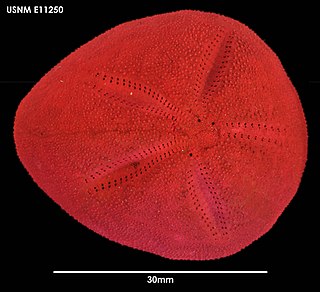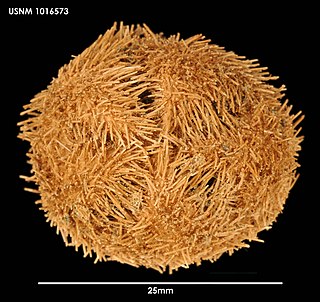Abatus elongatus is a species of sea urchin of the family Schizasteridae. Their armour is covered with spines. It came from the genus Abatus and lives in the sea. Abatus elongatus was first scientifically described in 1836 by Koehler.

Abatus ingens is a species of sea urchin of the family Schizasteridae. Their armour is covered with spines. It came from the genus Abatus and lives in the sea. Abatus ingens was first scientifically described in 1926 by Koehler.

Amphipneustes koehleri is a species of sea urchin of the family Temnopleuridae. Their armour is covered with spines. It is placed in the genus Amphipneustes and lives in the sea. Amphipneustes koehleri was first scientifically described in 1905 by Ole Mortensen.

Amphipneustes similis is a species of sea urchin of the family Temnopleuridae. Their armour is covered with spines. It is placed in the genus Amphipneustes and lives in the sea. Amphipneustes similis was first scientifically described in 1936 by Ole Mortensen, Danish zoologist.
Amphipneustes tumescens is a species of sea urchin of the family Temnopleuridae. Their armour is covered with spines. It is placed in the genus Amphipneustes and lives in the sea. Amphipneustes tumescens was first scientifically described in 1926 by Koehler.
Aspidodiadema jacobyi is a small sea urchin in the family Aspidodiadematidae. It lives in tropical seas at great depths. Aspidodiadema jacobyi was first scientifically described in 1880 by Alexander Emanuel Agassiz, an American scientist.
Argopatagus vitreus is a species of sea urchin of the family Macropneustidae. Their armour is covered with spines. It is placed in the genus Argopatagus and lives in the sea. Argopatagus vitreus was first scientifically described in 1879 by Alexander Emanuel Agassiz, an American scientist.
Aspidodiadema africanum is a species of sea urchin of the family Aspidodiadematidae. Their armour is covered with spines. It is placed in the genus Aspidodiadema and lives in the sea. Aspidodiadema africanum was first scientifically described in 1939 by Ole Theodor Jensen Mortensen, a Danish scientist.

Aspidodiadema arcitum is a species of sea urchin of the family Aspidodiadematidae. Their armour is covered with spines. It is placed in the genus Aspidodiadema and lives in the sea. Aspidodiadema arcitum was first scientifically described in 1939 by Ole Theodor Jensen Mortensen, a Danish scientist.

Aspidodiadema hawaiiense is a species of sea urchin of the family Aspidodiadematidae. Their armor is covered with spines. It is placed in the genus Aspidodiadema and lives in the sea. Aspidodiadema hawaiiense was first scientifically described in 1939 by Ole Theodor Jensen Mortensen, a Danish scientist.
Aspidodiadema intermedium is a species of sea urchin of the family Aspidodiadematidae. Their armour is covered with spines. It is placed in the genus Aspidodiadema and lives in the sea. Aspidodiadema intermedium was first scientifically described in 1977 by Shigei.
Aspidodiadema meijerei is a species of sea urchin of the family Aspidodiadematidae. Its armor is covered with spines. It is placed in the genus Aspidodiadema and lives in the sea. Aspidodiadema meijerei was first scientifically described in 1906 by Döderlein.
Aspidodiadema montanum is a species of sea urchin of the family Aspidodiadematidae. Their armour is covered with spines. It is placed in the genus Aspidodiadema and lives in the sea. Aspidodiadema montanum was first scientifically described in 1981 by Mironov.
Aspidodiadema sinuosum is a species of sea urchin of the family Aspidodiadematidae. Their armour is covered with spines. It is placed in the genus Aspidodiadema and lives in the sea. Aspidodiadema sinuosum was first scientifically described in 1981 by Mironov.
Aspidodiadema tonsum is a species of sea urchin of the family Aspidodiadematidae. Their armour is covered with spines. It is placed in the genus Aspidodiadema and lives in the sea. Aspidodiadema tonsum was first scientifically described in 1879 by Alexander Emanuel Agassiz.

Asterechinus elegans is a species of sea urchin of the family Trigonocidaridae. Their armour is covered with spines. It is placed in the genus Asterechinus and lives in the sea. Asterechinus elegans was first scientifically described in 1942 by Ole Theodor Jensen Mortensen.
Asthenosoma dilatatum is a species of sea urchin of the family Echinothuriidae. Their armour is covered with spines. It is placed in the genus Asthenosoma and lives in the sea. Asthenosoma dilatatum was first scientifically described in 1934 by Ole Theodor Jensen Mortensen.
Caenopedina depressa is a species of sea urchins of the Family Pedinidae. Their armour is covered with spines. Caenopedina depressa was first scientifically described in 1927 by Koehler.
Centrostephanus nitidus is a species of sea urchins of the Family Diadematidae. Their armour is covered with spines. Centrostephanus nitidus was first scientifically described in 1927 by Koehler.
Aspidodiadema is a genus of echinoderms belonging to the family Aspidodiadematidae.






